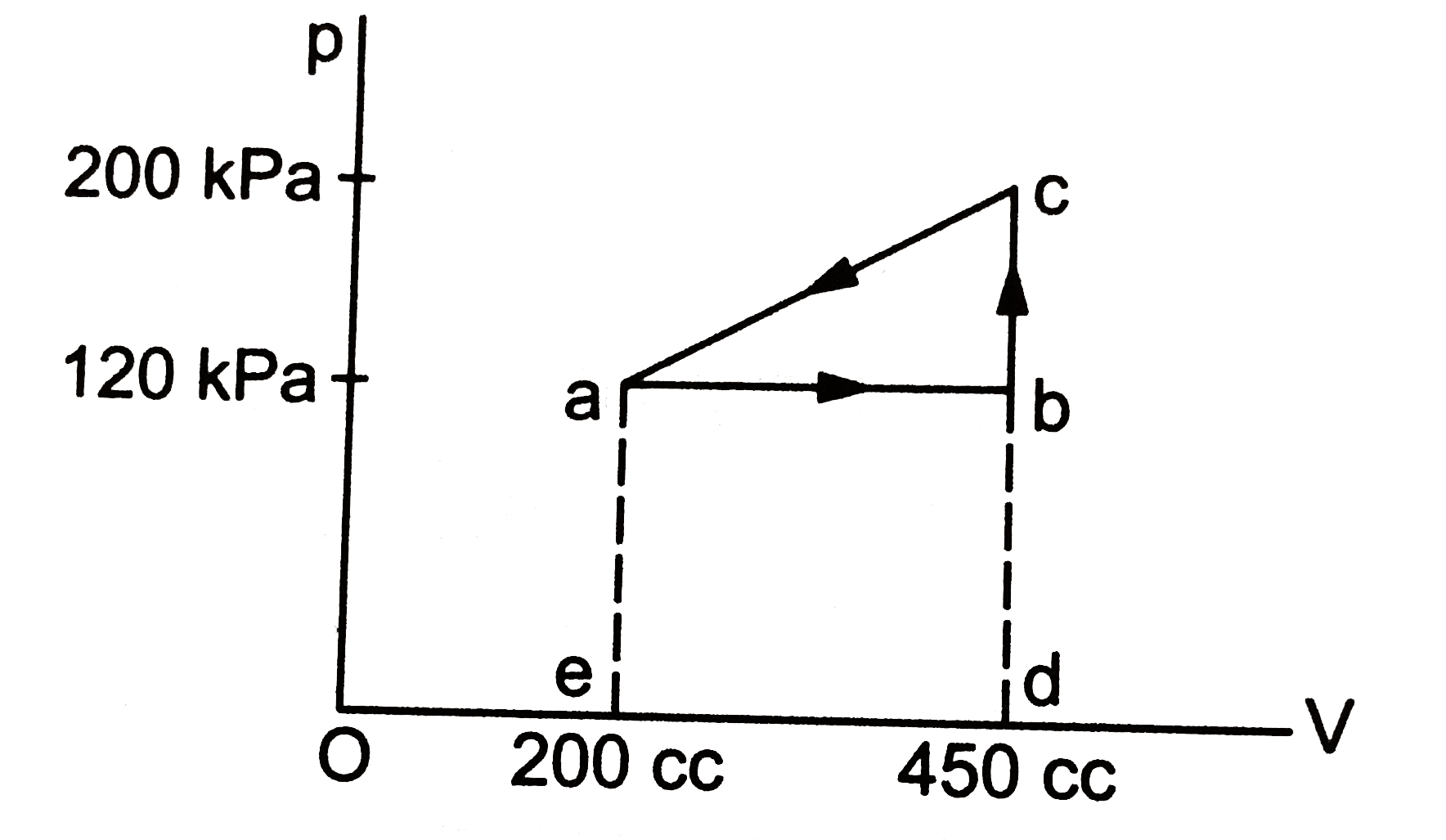calculate the work done by a gas as it is taken from the state a to b, b to c and c to a as shown in
 Solution in Tamil
Solution in Tamil
The work done by the gas in the process a to b is the area of adde. This is
W_(ab)=(120kPa)(250_(cc)
=120×103×250×10−6J=30J.
In the process c to a the gas is compressed. The volume is decreased and the work done by the gas is negative.the magnitute is equel to the area of caed. this area is cab + baed
=(1)/(2)(20 kPa)(250 cc)+30J
10J+30J=40J.
Thus, the work done in the process c to a is-40J.
Topper's Solved these Questions
- LAWS OF THERMODYNAMICSBOOK - HC VERMACHAPTER - LAWS OF THERMODYNAMICSEXERCISE - Worked out Example
11 Videos
- LAWS OF THERMODYNAMICSBOOK - HC VERMACHAPTER - LAWS OF THERMODYNAMICSEXERCISE - Objective I
9 Videos
- KINETIC THEORY OF GASESBOOK - HC VERMACHAPTER - KINETIC THEORY OF GASESEXERCISE - All Questions
120 Videos
- NEWTON'S LAWS OF MOTIONBOOK - HC VERMACHAPTER - NEWTON'S LAWS OF MOTIONEXERCISE - Exercises
42 Videos
Similar Questions
A sample of an ideal gas is taken through the cyclic process abca . It absorbs 50 J of heat during the part ab, no heat during bc and rejects 70 J of heat during ca. 40 J of work is done on the gas during the part bc.(a) find the internal energy of the gas at b and c if it is 1500 J at a. (b) calculate the work done by the gas during the part ca.

View SolutionThe first law of theromodynamics is a statement of
View SolutionCalculate the rms speed of nitrogen at STP (pressure =1 atm and temperature =00C. The density of nitrgoen in these conditions is 1.25kgm−3
View SolutionA block of mass 2 kg placed on a long frictionless horizontal table is pulled horizontally by a constant foerce F. It is found to move 10 m in the first two seconds. Find the magnitude of F.
View Solutionshows three paths through which a gas can be taken from the state A to the state B. calculate the work done by the gas in each of the three paths.


View SolutionThe state of an ideal gas is changed through an isothermal process at temperature T0 as shown in figure. The work done by the gas in going from state B to C is double the work done by gas in going from state A to B. If the pressure in the state B is p02, then the pressure of the gas in state C is

View SolutionCalculate the work done by the gas in the state diagram shown.

View Solution
As shown in figure three paths through which a gas can be taken from the state A to the state B. Calculate the work done by the gas in each of the three paths.
View SolutionA sample of ideal gas is taken through the cyclic process shown in the figure. The temerauture of the gas in state A is TA =200 K. In states B and C the temperature of the gas is the same.

Net work done by the gas in the process is
View Solutionचित्र में, किसी गैस के लिए दाब-आयतन आरेख (P-V diagram) दर्शाया गया है।
ग्राफ से ज्ञात कीजिए-
गैस को अवस्था B से C तक ले जाने में किया गया कार्य।

View SolutionCalculate the work done by the gas in the state diagram shown :

View SolutionA gas is taken through the cycle A to B to C to A, as shown. What is the net work done by the gas?
View SolutionAn ideal gas is taken in a cyclic process as shown in the figure. Calculate (a) work done by the gas. (b) work done on the gas (c ) Net work done in the process
View SolutionFigure shows three paths through which a gas can be taken from the state A to the state B. Calculate the work done by the gas in each of the three paths.

View SolutionA gas is taken through the cycle A→B→C→A, as shown. What is the net work done by the gas ?

View Solutionshows three paths through which a gas can be taken from the state A to the state B. calculate the work done by the gas in each of the three paths.

View Solution
